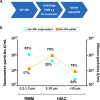Physical characterization and in vitro biological impact of highly aggregated antibodies separated into size-enriched populations by fluorescence-activated cell sorting
- PMID: 25753756
- PMCID: PMC4448733
- DOI: 10.1002/jps.24379
Physical characterization and in vitro biological impact of highly aggregated antibodies separated into size-enriched populations by fluorescence-activated cell sorting
Abstract
An IgG2 monoclonal antibody (mAb) solution was subjected to stirring, generating high concentrations of nanometer and subvisible particles, which were then successfully size-enriched into different size bins by low-speed centrifugation or a combination of gravitational sedimentation and fluorescence-activated cell sorting (FACS). The size-fractionated mAb particles were assessed for their ability to elicit the release of cytokines from a population of donor-derived human peripheral blood mononuclear cells (PBMC) at two phases of the immune response. Fractions enriched in nanometer-sized particles showed a lower response than those enriched in micron-sized particles in this assay. Particles of 5-10 μm in size displayed elevated cytokine release profiles compared with other size ranges. Stir-stressed mAb particles had amorphous morphology, contained protein with partially altered secondary structure, elevated surface hydrophobicity (compared with controls), and trace levels of elemental fluorine. FACS size-enriched the mAb particle samples, yet did not notably alter the overall morphology or composition of particles as measured by microflow imaging, transmission electron microscopy, and scanning electron microscopy-energy dispersive X-ray spectroscopy. The utility and limitations of FACS for size separation of mAb particles and potential of in vitro PBMC studies to rank-order the immunogenic potential of various types of mAb particles are discussed.
Keywords: IgG; immune response; immunogenicity; PBMC; in vitro; monoclonal antibody; particles; protein aggregation; proteins.
© 2015 Wiley Periodicals, Inc. and the American Pharmacists Association.
Figures









Similar articles
-
Comparative Evaluation of Two Methods for Preparative Fractionation of Proteinaceous Subvisible Particles--Differential Centrifugation and FACS.Pharm Res. 2015 Dec;32(12):3952-64. doi: 10.1007/s11095-015-1755-6. Epub 2015 Jul 21. Pharm Res. 2015. PMID: 26195006
-
Label-free flow cytometry analysis of subvisible aggregates in liquid IgG1 antibody formulations.J Pharm Sci. 2014 Jan;103(1):90-9. doi: 10.1002/jps.23782. Epub 2013 Nov 11. J Pharm Sci. 2014. PMID: 24218205
-
Compatibility, physical stability, and characterization of an IgG4 monoclonal antibody after dilution into different intravenous administration bags.J Pharm Sci. 2012 Oct;101(10):3636-50. doi: 10.1002/jps.23224. Epub 2012 Jun 25. J Pharm Sci. 2012. PMID: 22733600
-
Structural characterization of IgG1 mAb aggregates and particles generated under various stress conditions.J Pharm Sci. 2014 Mar;103(3):796-809. doi: 10.1002/jps.23839. Epub 2014 Jan 22. J Pharm Sci. 2014. PMID: 24452866 Free PMC article.
-
Calculating the mass of subvisible protein particles with improved accuracy using microflow imaging data.J Pharm Sci. 2015 Feb;104(2):536-47. doi: 10.1002/jps.24156. Epub 2014 Oct 9. J Pharm Sci. 2015. PMID: 25302696
Cited by
-
Comparative Evaluation of Two Methods for Preparative Fractionation of Proteinaceous Subvisible Particles--Differential Centrifugation and FACS.Pharm Res. 2015 Dec;32(12):3952-64. doi: 10.1007/s11095-015-1755-6. Epub 2015 Jul 21. Pharm Res. 2015. PMID: 26195006
-
Physical Characterization and Innate Immunogenicity of Aggregated Intravenous Immunoglobulin (IGIV) in an In Vitro Cell-Based Model.Pharm Res. 2016 Jul;33(7):1736-51. doi: 10.1007/s11095-016-1914-4. Epub 2016 Apr 1. Pharm Res. 2016. PMID: 27037576
-
Submicron immunoglobulin particles exhibit FcγRII-dependent toxicity linked to autophagy in TNFα-stimulated endothelial cells.Cell Mol Life Sci. 2024 Aug 30;81(1):376. doi: 10.1007/s00018-024-05342-9. Cell Mol Life Sci. 2024. PMID: 39212707 Free PMC article.
-
A High Threshold of Biotherapeutic Aggregate Numbers is Needed to Induce an Immunogenic Response In Vitro, In Vivo, and in the Clinic.Pharm Res. 2024 Apr;41(4):651-672. doi: 10.1007/s11095-024-03678-2. Epub 2024 Mar 22. Pharm Res. 2024. PMID: 38519817
-
Editor's Highlight: Subvisible Aggregates of Immunogenic Proteins Promote a Th1-Type Response.Toxicol Sci. 2016 Oct;153(2):258-70. doi: 10.1093/toxsci/kfw121. Epub 2016 Jun 30. Toxicol Sci. 2016. PMID: 27370416 Free PMC article.
References
-
- Boven K, Knight J, Bader F, Rossert J, Eckardt KU, Casadevall N. Epoetin-associated pure red cell aplasia in patients with chronic kidney disease: solving the mystery. Nephrology, dialysis, transplantation: official publication of the European Dialysis and Transplant Association - European Renal Association. 2005;20(Suppl 3):iii33–40. - PubMed
-
- Casadevall N. What is antibody-mediated pure red cell aplasia (PRCA)? Nephrology, dialysis, transplantation: official publication of the European Dialysis and Transplant Association - European Renal Association. 2005;20(Suppl 4):iv3–8. - PubMed
-
- Chirino AJ, Ary ML, Marshall SA. Minimizing the immunogenicity of protein therapeutics. Drug Discov Today. 2004;9(2):82–90. - PubMed
-
- Claman HN. Tolerance to a Protein Antigen in Adult Mice and the Effect of Nonspecific Factors. Journal of Immunology. 1963;91:833–839. - PubMed
Publication types
MeSH terms
Substances
Grants and funding
LinkOut - more resources
Full Text Sources
Other Literature Sources

